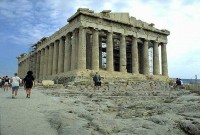Through Spanish Eyes, the Parthenon Moves an Athenian
 When Sigmund Freud visited the Acropolis and the Parthenon for the first time in 1904, he reportedly couldn’t believe that it really existed as he had learned about it in school. Mary Beard wrote in her book, The Parthenon, that Freud had said he felt like he was walking by the lake of Loch Ness and had spotted the legendary monster. It was, he said, only seeing it with his own eyes that made him believe the Acropolis really existed.
When Sigmund Freud visited the Acropolis and the Parthenon for the first time in 1904, he reportedly couldn’t believe that it really existed as he had learned about it in school. Mary Beard wrote in her book, The Parthenon, that Freud had said he felt like he was walking by the lake of Loch Ness and had spotted the legendary monster. It was, he said, only seeing it with his own eyes that made him believe the Acropolis really existed.
That was how my two Spanish friends, Carlos Martinez and Isabella Rodriguez, felt when the first encountered the Parthenon. “I could never have imagined that I would feel such awe when I first saw it, even though I had seen it many times in photographs,” Martinez said. It was interesting to see how differently people from other countries see the ancient temple compared to the Greeks, especially Athenians. It seems that even when Athenians have the time to visit the Parthenon, they postpone it.
It was a Saturday morning when Martinez, Rodriguez and I decided to visit the Parthenon. We met in Thiseio, got a cup of coffee to go and started on our way to the temple. We were all very excited, because it was the first time for them to visit Acropolis and I hadn’t been there for a long time. Despite the fact that we had our guide book guide with us, we tagged along with a group of tourists that had a tour guide to learn as much as we could.
Started in 447 BC by the famous Greek architects Ictinus and Kalikratis, the Acropolis was completed in 438 BC, although the embellishment of the temple was only finished in 432 BC. As the name of the city implies, Athens in ancient Greece had as its protector the Greek goddess Athena, the goddess of wisdom and war. The temple is dedicated to the virgin Greek goddess; hence its name.
Inside the temple stood a gigantic sculpture of Athena, made by Phidias around 439 BC. The statue, the guide informed us was 13 meters tall and located in the center of the Parthenon. “It is estimated that during the 3rd century B.C. the statue’s gold was removed from it and in the 2nd century BC a fire damaged parts of it,” the guide continued as we admired the Parthenon from different angles. “The sculpture was taken away sometime during the Middle Ages and not a single piece of it survives today.”
As time passed, and the sun began to set, we gazed at the marbles as they took on different colors. We stood still for a moment, just to breathe and feel the cool breeze on our faces. Rodriguez closed her eyes and when she opened them again, her face sparkled. “I can’t explain how grateful I feel that I had the chance to see this,” she said. “You must feel very lucky you can come and visit it any time you want,” Martinez said.” But do we Athenians feel lucky? Or does it take a visitor from another country to appreciate the Acropolis?
We were sitting on a rock, admiring the view of the city of Athens, preparing for the night, when a man who worked at the Acropolis informed us that it was time to go. The monument was closing. We headed back down to modern civilization feeling like time had stopped up there for a moment, to let us travel back a few thousand years before returning to our everyday lives.
As we were leaving the Parthenon behind, I thought I could hear the words of Melina Merkouri flowing through the marbles: “The world over, the very name of our country is associated with the Parthenon”. When you see it, you understand why.